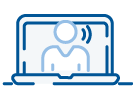Let’s face it: Patients are frustrated by confusing and inconvenient healthcare payment experiences. They may not fully understand deductible resets or their healthcare plan’s policies. Here are tips to improve your conversations with patients about their financial responsibility.
Here are three kinds of conversations you can initiate to change the payments relationship with patients after deductibles reset.
“What payment method would you like us to keep saved on file?”
It is important to take a proactive approach to patient collections by starting the payment conversation early on. Consider creating a policy where all patients keep payment methods saved on file with your organization. This will make collecting payments from patients easier and help establish that patients are expected to cover their portion of their healthcare responsibility. If a patient asks why they need to save a card on file, try these responses:
- “We ask all patients to keep a card saved on file; it’s our policy.”
- “Based on your coverage and benefit information, you’re going to owe some amount for this healthcare encounter – we’ll use this card to collect the payment once your responsibility has been determined by your health plan.”
Ensure you and your staff have visibility into patient benefit information so they can be prepared for any conversation. This will help you answer questions patients may have about their payment responsibility, or you can use this information to determine an estimate of what the patient may owe. If you do offer a payment estimate, consider collecting a portion of the healthcare payment upfront. Not only is this good for cash flow, but it also makes payment easier for patients. When they do receive a bill, they’ve already made some payment on it, making it seem lower than expected or like they’ve already made good progress on paying it back. This creates a more positive experience than receiving an overwhelming bill, and repayment hasn’t even started.
“We want to make this easy for you.”
Once you have a patient’s payment method saved on file, talk to them about automatic payments. At first, patients might be intimidated by the idea of letting you charge their card to collect their responsibility – especially if the responsibility may be in the thousands. You can ease patient concerns by establishing a charge limit. This lets patients know the maximum amount they will be charged and leads to conversations about other payment options like payment plans.
Interactions like this not only increase your likelihood of getting paid but
“We know healthcare payments can be confusing.”
Being proactive about collecting patient payments means finding ways to engage patients in the process at every touchpoint. Reach your patients before a healthcare interaction even occurs to help alleviate some of the confusion in paying a healthcare bill. Engage with patients pre-service through their mobile devices to help them understand their benefits information and learn what options they have to make a payment. Show them how to access your patient portal so they can sign up, select communication preferences, and save a payment method on file to make payment easily once the bill comes.
Additionally, it is important to remember that every patient is different. Some patients may prefer to do everything over the phone while others may want to access their healthcare information and bills right from their mobile devices. Give your patients convenient features such as the ability to take a photo of their statement and easily pay it through their mobile phones. For patients who may not want to pay this way, make sure they know that they other options, including paying a balance over the phone or setting up payments through their bank bill pay portal. Options give patients convenience and show that you respect their preferences. Show your patients you care by giving them simple and easy ways to pay their bills.
Track Your Progress!
Now that you have implemented new payment processes at your organization, it is important to track your progress. To maximize the benefits of payment technologies, providers need to have insight into their receivables data to know what’s working and why it’s working, then adjust resources accordingly.
Use reporting tools to monitor your patient payments and see if your new payments approach is working. It is crucial to track the performance of new collection initiatives over a long period of time and have the flexibility to report on performance in a way that best suits your organization (e.g., quarterly, annually, monthly, etc.). Then use this data to make more informed business decisions to help you improve collections.

